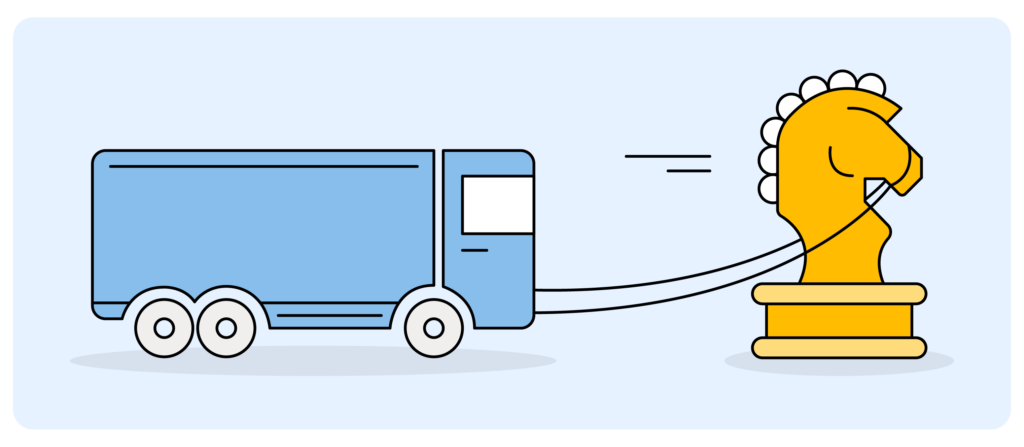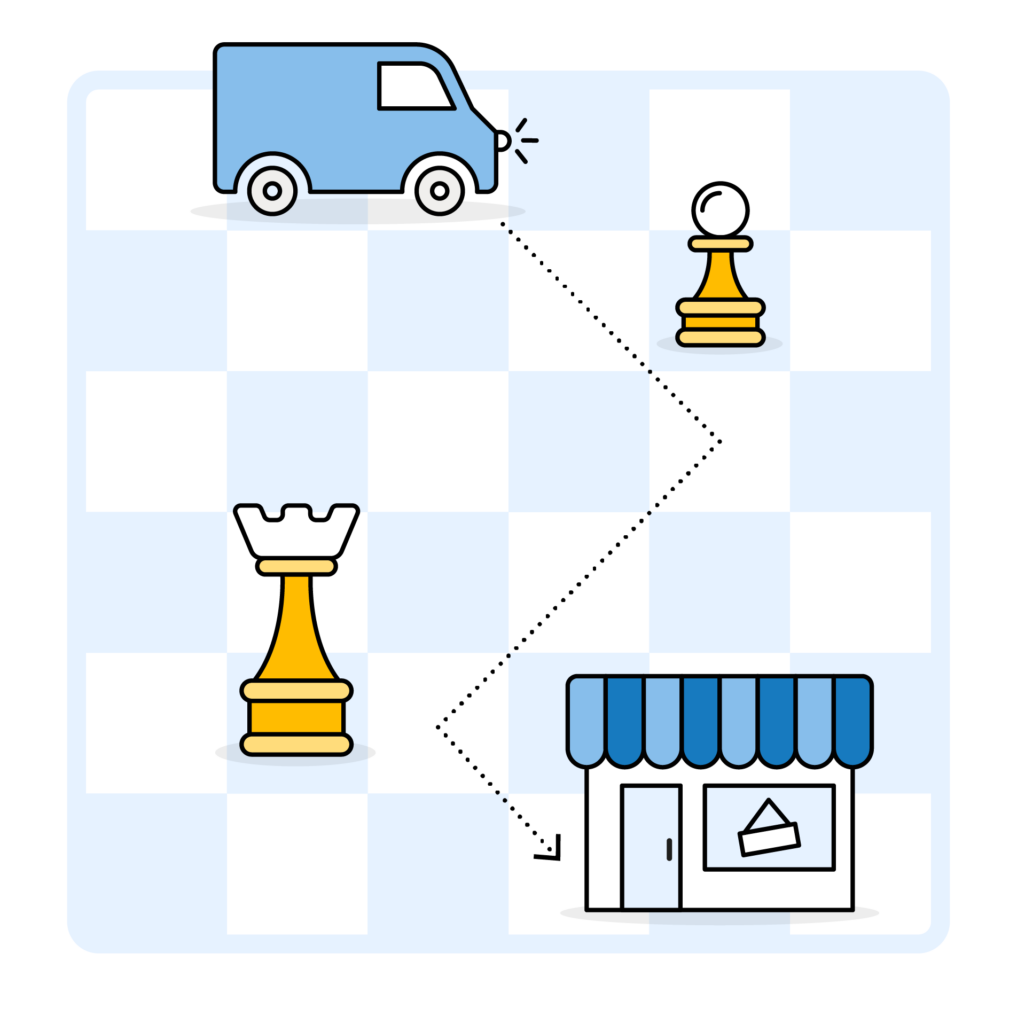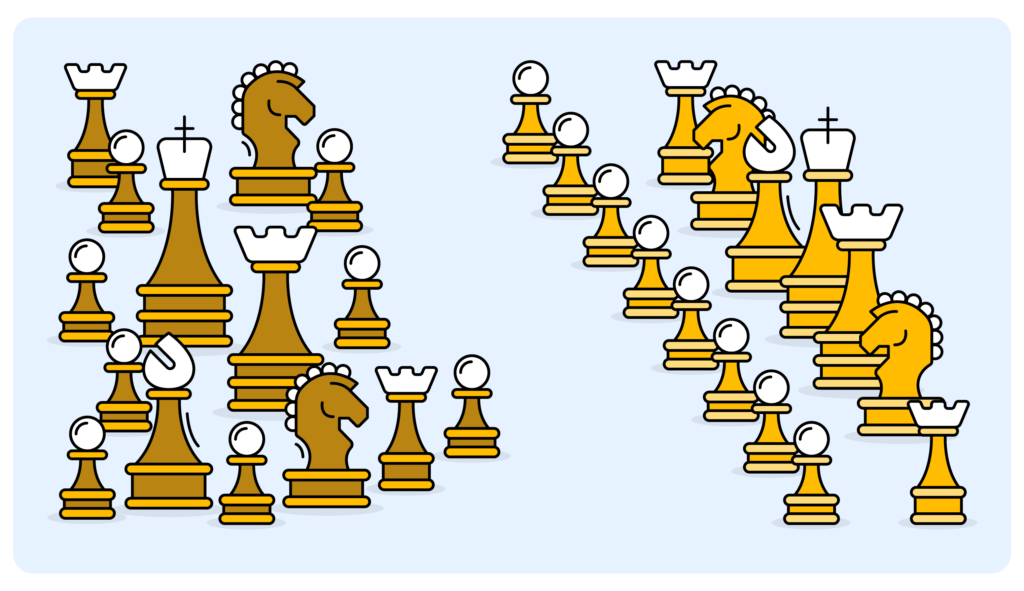
Supply chain transformation: Before you start
Supply chain management was once a relative backwater, but it has moved decisively to center stage in recent years. A well-managed supply chain operation is, increasingly, a critical factor, even the critical factor, in a business’s success. This guide to supply chain transformation leads you through the process of aligning retail and supply chain planning with a business’s strategic goals, all the way to technical implementation.
Transforming a supply chain operation and bringing it up to date generally involves not just the introduction of powerful new technology but a fundamental review of processes and organization.
There is no single ‘right’ approach, but what is common to almost every successful transformation is that it seeks to align the supply chain with the company’s overall goals. For many businesses, finding the right supply chain system is essential in identifying the steps they need to take to optimize their supply chain to better serve their business needs. If you are considering sourcing supply chain technology, especially a supply chain management system encompassing demand planning and data analytics, take time to assess the available options.
Start by asking the essential questions – especially of yourself.
Tip: The most critical question you’ll want to ask yourself is, undoubtedly, “What do we want to achieve?”
It could be more streamlined processes, better availability, lower inventory levels, less spoilage, less manual work, better forecasting of campaigns and promotions, better ramp downs and, ultimately, higher sales and higher profits. However, it helps to identify one or two KPIs that are the most important and by which success can be measured. Those KPIs tend to reflect a company’s overarching business strategy.
In this guide, we’ll be looking at those areas that, in our experience, are the most important to consider:
- Is supply chain transformation something you should be working towards now?
- How do you organize your replenishment operations?
- What does leadership mean in the context of a supply chain transformation project?
- Do you develop a solution in-house or look outside for a supply chain systems specialist?
- How to structure your project?
With supply chain strategy so high up on the business agenda these days, and with it being so critical in the face of ever-fiercer competition, this is an issue every business must face sooner or later!
1. What is supply chain transformation?
Why you, why now?
Two reasons stand out. Firstly, you could save money quickly.
Tip: In any move to optimize supply chain operations, there are almost always several ‘low hanging fruit’ issues that are relatively straightforward to fix and can, if resolved, produce measurable results fast. You can save money and give a transformation project real momentum by identifying quick wins.
Secondly, whether you optimize your supply chain, there’s every chance your competitors have or will. The big retailers, particularly the giants of online and omnichannel, are revolutionizing supply chain and fulfilment standards. Consumer expectations are constantly being driven higher. The purchases they make are increasingly affected by availability, price, assortment, and speed of delivery. You can improve all these, helping you keep or gain a competitive edge.
What is supply chain transformation really about?
The supply chain transformation process primarily involves aligning the supply chain with your overarching business goals for maximum efficiency. In practice, it’s not so much about material flows as changing responsibilities within the organization, and that requires a step-by-step, strategic approach.

1. Be clear about your main strategic business goals. To transform its supply chain, a business should have a clear commercial vision. Whether it’s a niche retailer, a discounter, all about quality, service, or availability, whether it aims for depth or breadth of assortment, sets trends or responds to them, it should decide on its goals and orientate its supply chain operations around them.

2. Let your strategic goals shape your supply chain goals. Asking questions about strategic positioning, such as where the retailer’s competitive edge is and how that is formed, leads to a second set of goal-related questions about sourcing; “What do we want to provide our customers? Do we need the stock to last the whole season or longer? Do we go for low cost – long lead time, local and short lead but at higher cost?” or a mix, etc. These questions lead to any number of category management, buying, merchandising and campaign-related supply decisions.

Tip: It helps if businesses are willing to consider new ways of working (We discuss one of these, organizing your replenishment operations and team, in Chapter 2).
And yet, occasionally, all a business wants to do is automate its existing supply chain. But if a process isn’t working well, automation won’t improve it. It simply allows that sub-optimal process to continue out of sight and mind, with even less thought given to what’s not working. As one great business leader once said, “Automating stupidity just gives you stupidity automatically.”
“A long habit of not thinking a thing wrong gives it a superficial appearance of being right and raises at first a formidable outcry in defense of custom.”
Thomas Paine
Just because something has always been done in a certain way doesn’t necessarily mean it’s the best way.
It’s a people thing
Transforming the way colleagues think about the supply chain, their place in it and how they work is critical. Getting your fellow workers onboard and involved is often the difference between mere implementation and fundamental transformation, particularly for those at the sharp end.
Companies with one or more good super-users implement faster and more effectively and get better results. Someone on the inside who understands the business and the system can ensure the supply chain planning solution seamlessly extends a business’s operations. Being able to drive the system from within the organization means that the supply chain team can translate colleagues’ expertise into automated processes faster, implement changes as needed, and keep the communications chain short.
Let your system and people do what each does best. Intuition and experience are better than nothing when hard data is unavailable, but hard data almost always trumps intuition. Humans can’t keep week-by-week sales for thousands of SKUs in mind. A good system can, effortlessly. Humans understand other humans far better than computers. Let each play to their strengths.
Free experts to use their skills. There’s no point letting your experts get bogged down in routine, repetitive work when it’s easy to automate. Let colleagues focus on tasks that can’t be automated but that improve the bottom line; their expertise in sourcing new products or suppliers, negotiating the best deals and keeping an eye on the market all add real value.
But don’t forget that managing any transformation project’s human dimension is almost always the most challenging task and takes leadership skills and sensitivity—more in our next chapter.
From supply chain strategy to measurable targets
Your overall business strategy largely determines specific targets regarding availability, inventory levels, and purchase and logistics costs. Right from the outset, before you commit to implementing a particular system, you should work closely with a solution provider to ensure that they understand your goals and that the system will reflect them properly.
Try to define these goals as closely as possible, especially their relative priority. So, is your primary aim to offer full availability, reduce capital investment in stock or reduce the logistics costs – and what is the order of priority of your various targets?
These goals might even be given a different weight within a subsidiary business, specific categories, or even at the regional/individual store/SKU level.
Benchmarking your progress is also helpful to ensure your strategy is on track. There are regular KPIs, such as inventory, availability, spoilage and so forth. But in terms of organizational and operational efficiency, while many of the gains are intangible – store staff having more time to spend with customers, for instance, or less stressed warehouse and supply chain teams – there are still good indicators.
Tip: Track your progress by keeping tabs on staff hours used for given tasks before, during, and after the transformation.
You can measure how fast you can make changes in the supply chain, such as planning a campaign, a new store opening, or a Christmas season. For example, whereas previously, a three-person team took two months to plan deliveries and supply chain operations for Christmas, the same process might be possible with a two-person team in one week after the transformation.
2. Organizing your replenishment operations
Some businesses already have an organizational model they are happy with and would prefer to refine it rather than make outright changes. They may already use replenishment software and simply look for improved or more integrated functionality.
However, it’s often the case that supply chain transformation initiatives often prompt organizational changes. So, a critical decision for retailers, arguably the most important in organizational terms, is whether to use a centralized or decentralized model for replenishment planning and purchasing.
The decentralized approach
here are circumstances when a decentralized approach is wholly sensible. For instance, where:
- Stores have a degree of autonomy to alter order proposals – generally, the only decentralized option countenanced by large retailers.
- Ordering in a multinational company is done by a different team in each national territory – local knowledge and potential language difficulties may be important considerations.
- Product managers, rather than a dedicated specialist purchasing team, are entirely responsible for ordering – not uncommon in the wholesale sector.
So, when businesses decide a decentralized model works, it’s generally because it has advantages in their particular circumstances. For instance:
- It can help subsidiary companies or local operations retain their individual character.
- It can increase the accountability in the stores when they have the final decision-making responsibility.
- It can work better for franchised businesses.
The centralized approach
In many cases, companies we’ve worked with have been able to centralize much of their supply chain decision making. This centralization is almost always decisive as it allows the company to bring all its expertise to bear through effective systems with the ability to respond faster to any situation. The central team has an overview of the whole chain and much closer control of material flow across the board.
The building of central replenishment teams is a broad trend amongst businesses. Today, it’s widely considered ‘best practice’ as it’s highly effective and has numerous advantages.
- Good for companies wanting uniformity across wide-ranging national or multinational operations.
- Helps maximize the benefit from the latest ‘in-memory’ powered planning and data analytics tools.
- Brings together a critical mass of skills and knowledge and creates an environment for sharing both.
- Centralization is essential for system development and support (ideally with a nominated super-user to lead it)
- Makes it easier to cover in the event of leave, illness or colleagues changing jobs.
These days, the centralized approach is broadly considered the best practice. In the absence of contrary factors, the case for centralizing the supply chain team, and with it inventory planning and replenishment, management is powerful.
Super-users
In large retail companies, a solid organizational structure generally includes a super-user team. In very large retailers with multi-billion-dollar turnovers and hundreds of stores, purchasing teams are often quite large. There might be 2 to 6 super-users within that team because the scope of use is so broad.
Super-users should receive appropriate training. It’s often more effective when super-users have come from different parts of the organization because team members bring a breadth of knowledge that they share with one another, which helps in crafting solutions for a wide range of challenges.
Even if a business has chosen, for well-considered reasons, to pursue a decentralized approach and allocate super-users to its supply chain teams in different regions, countries or subsidiaries, regularly bringing super-users together helps the exchange of knowledge and ideas.
Supply chain processes and organizational changes often go together
When businesses decide to review and rework their supply chain processes, it often follows that the organization needs to be reconfigured to reflect new chains of responsibility or working teams.
For example, where individual stores have their own manual ordering process, a typical supply chain transformation response will be to centralize ordering. Stores keep responsibility for monitoring inventory levels and ensuring new stock gets on the shelves quickly.
Another example is product allocations to stores. In some companies, the merchandise planning team takes care of pre-season ordering. The replenishment team handles daily replenishment and allocation to stores. It takes responsibility for the close management of stock but leaves the more strategic management to merchandising teams. Other companies have a single team that simultaneously places orders and calculates how that stock will be divided between outlets.
We recommend, in most instances, a centralized planning team. The model is being adopted across retail and wholesale for good reasons. The examples above are just two from a host we’ve encountered that illustrate the logic of centralization.
The right technology and a skilled team of supply chain experts who know how to use it consistently outperform the instincts of even the most experienced store managers when forecasting routine replenishment, promotions, seasons, and campaigns.
As outlined above, there are sometimes good reasons to use a decentralized model. For those excepted, the centralized approach is generally agreed to be the industry’s best practice. However, where there is a compelling case for decentralization, it may still be that some high-level aspects of the operation are still best centralized, such as system development and support. Likewise, a solid economic case exists for coordinating and consolidating buying to maximize bargaining power and strike more advantageous deals.
A good system can be adapted to deliver the best of both worlds to companies that run different retail chains, where different territories remain highly distinctive, where there are franchisees, and where some local autonomy is essential.
3. Leading your supply chain transformation initiative
We’ve highlighted three straightforward steps to define what supply chain transformation means for your company: identifying and working towards your business goals, your supply chain goals, and the planning processes needed to deliver them. We’ve looked at organizing your supply chain team and touched on the fact that reorganization often follows process changes and vice versa.
Having settled on your vision for supply chain transformation, you will undoubtedly encounter several challenges as you forge ahead. Some are more significant but resolving them is usually simply a process.
The issue that gets raised time and time again is:
Winning support from colleagues for a supply chain transformation project is far from a simple, straightforward process. Change management is one of the most challenging tasks business executives must handle. Bringing your people with you requires leadership. But with skill and experience, it can be done and can be transformative.
If you master the art of change management, you’ll reach a tipping point where the push will become a pull. You won’t be telling people they must do things a certain way. They’ll show you what they can do with the tools and processes you introduce. They’ll have taken ownership of the system and the supply chain transformation process.
So, where do you start?
There are two dynamics typically at work. One is top-down, and the other is bottom-up, and they are reflected in two distinct leadership roles involved in a good supply chain transformation initiative. We refer to these as ‘the Leader’ and ‘the Champion’.
The leader is the person who drives through the project from the top down, whereas the champion provides vital impetus from the bottom up. One person could take on both roles. Equally, a project could have more than one champion. However, ultimately, for clarity and efficiency, it generally helps to have a single person assume the role of leader.
The Leader

Tip: Find a project leader who can straddle the business and technical sides of the project.
The project leader needs to understand the business’s goals and why those goals are important and keep them at the center of the project. We’ve worked with great project leaders who don’t have technical backgrounds. However, it’s a big plus if they’re prepared to engage with and get stuck into the technical aspects of the project. Such people get the best results in the fastest time because they’re not afraid to get their hands dirty. They also need good interpersonal skills. Their job is to keep senior management onboard, their team happy and motivated, and forge a great working relationship with the technology supplier and, sometimes, third-party vendors and IT subcontractors.
Where should the leader come from? It could well be the person who drove the decision to undertake the supply chain transformation in the first place. Another obvious choice would be someone from the supply chain team, probably senior. That could be the same person. In any case, they should be working very closely with the supply chain team as it’s doing the heavy lifting, which is, in many ways, its project. It should shape the current plans, considering essential changes, where restrictions apply and what cannot be touched. However, if someone with excellent personal and organizational skills is genuinely determined to get grease under their nails on the technical side, the leader could be drawn from outside the supply chain team.
Tip: For a transformation project to succeed, it needs the backing of an organization’s senior management.
The earliest conversations are typically with whoever is ‘in pain’ at the time, operationally speaking. That might be the CFO wanting to free up capital by reducing inventory or cutting costs or the Supply Chain Director trying to respond to a range of requests in areas where he has insufficient control. That senior figure within the company could be the project leader themselves or, as an ally, play a crucial part in making the case to the board.
Tip: Making a business case showing the project will improve profitability and demonstrate low and manageable risks generally wins the board-level support that a project needs.
Something to bear in mind: we worked on a case where some senior people were concerned as much with guarding their own turf as with the company’s wellbeing. Their teams enjoyed considerable operational autonomy, and they all worked differently. Though it was decided to centralize supply chain planning and processes, convincing each department to come on board was a massive effort. What was lacking was someone at the top who could say, “This is what we need to do, and this is why we need to do it.”
When you get this “silo” mentality, people sometimes think about their own goals regardless of whether those support the business’s overarching goals or assist the dynamics between teams and their operations. A system does not resolve this, but it gives you powerful tools, such as allowing everyone to work with a single set of numbers. Then, if the promotion planner does something, the supply chain and category manager can immediately evaluate the potential results it could lead to.
Tip: Collect and organize your data, analyze it, and make your case. Good leadership allied with good data helps get people on board with a supply chain transformation.
And good data provides a solid basis for good communications. Colleagues may say, “We’ve always done it like that” or “We know our area best; you just take care of yours,” but numbers and projections allow you to respond to opinions with hard data, and that makes it much easier to find common ground or make compromises.
The Champion

Tip: Remember that people often relate to their peers more closely than their superiors.
If the role of the leader is to manage and motivate from the top down, then the champion’s job is more bottom-up, nurturing the project’s roots so that colleagues at the sharp end grow and thrive. The roles are different, but we know people who have been both great leaders and champions in their projects.
Being a supply chain transformation champion means listening to the concerns and taking care of the needs of the people who are going to be affected most directly by the transformation. Overwhelmingly, there will be people in stores, especially store managers, who find that their roles change.
Ideally, you will find a supply chain transformation champion, or champions, who understand and empathize with those who feel they have the most to lose or are most apprehensive. They should be someone who can show them a better future. A great supply chain transformation champion will have great powers of empathy and/or experience working in those parts of the business most profoundly affected by the change, such as stores.
They will need to persuade colleagues by giving them a vision of how their life will be afterwards, showing them their role and how they will be needed in the supply chain operation that’s coming.
One great suggestion we found was to invite people, possibly by sending out a general email, to become early adopters and champions. Those who respond quickly and enthusiastically are likely to be great candidates.
Tip: Don’t make change feel like a judgement on people’s performance. People hate it when something familiar is taken away, even if they don’t particularly like it. If you’re not careful, you can send a message of mistrust interpreted as, “We’ve got a new system that’s better than you are.”
If colleagues feel their worth has been undermined, they may try to show that their old roles cannot be automated and that the system can’t do the job. They will always be able to find a few cases to make their point.
And being right isn’t always enough.
In one implementation we worked on, the regular buyers went off for a month’s break. Their deputies were less familiar with the operation, so they chose to run the system on full automation throughout the holiday period. Everything was perfect. But once the regular managers returned, the situation deteriorated because they made the same mistakes they always did.
But you can’t get back on track by making people feel bad about the change and highlighting their mistakes when they protest. This is doubly true if you’re taking away responsibility and replacing someone’s expertise with a computer because it can affect their status and sense of worth.
Tip: Think carefully before choosing full automation; we rarely recommend it.
A good transformation champion will appreciate the local knowledge store managers offer (for instance, about upcoming events – matches, festivals, concerts, etc., that could affect demand) and ensure good communication. Store managers will sometimes retain order approval or perhaps control a long list of items and categories, at least while colleagues are learning to trust the system (and also because systems work best with human feedback). Interestingly, in some parts of the world, our smaller customers look for higher levels of automation. Larger companies everywhere typically like to give more control to their supply chain experts.
Tip: Give colleagues a personal goal. Company goals are critical, but those can seem remote and intangible to individuals.
One of the smoothest implementations we worked on had a key project lead and central replenishment planner who, having worked in the stores, understood keenly what store operations looked like and their supply chain pain points.
He communicated well with the store staff, the ultimate customers for the transformation project. That helped get them on board. That is critical because store staff ensure stock is available on the shelves for customers, that the numbers in the system are right, that inventory levels are correct, and that sales are correctly registered.
And there is an excellent future for store staff. An in-store transaction is still made between the customer and store colleague. If they’re committed to customer service, they will also see the benefits of having the right amounts of the right products and appreciate having more time with customers.
Tip: Look for potential quick wins and implement them – they’re essential and motivate the team, so they help immensely in change management.
Getting an early win shows people that the project has value and that they are gaining something. Too many people have seen projects that once started were never heard of again. So, it’s imperative to show as early as possible that this is leading somewhere.
4. Choosing a supply chain planning system
Optimizing your supply chain and developing your processes and organization step-by-step, each one thoroughly considered, all requires the analysis of large quantities of data. Thankfully, excellent software has been designed for this very purpose. So, having decided to proceed with your supply chain transformation process, evaluating whether your existing system (if you have one) is suitable for the task is essential. Can it handle your expanding business and supply chain needs or be upgraded to do so? Or do you need to consider replacing your existing system with a more modern, powerful, agile solution to support and better serve your supply chain planning processes now and in the future?
Do you develop in-house or look to a specialist provider?
Tip: Weigh the risks and costs of developing an in-house system versus a third-party solution.
Businesses generally have a clear idea of their core competencies. Some want to take on the challenge of developing an existing ERP or supply chain management system or building one from scratch.
Many companies have a skilled IT department that can implement and adapt a new system to that business’s needs. However, it’s an additional step to employ and maintain a specialist team of analysts to develop replenishment and forecast models and implement new replenishment and forecasting concepts. The knowledge and skill levels required are high. A company must satisfy itself that there is a business case, and many decide it is a distraction from their core operations.
Updating or developing an existing system may be attractive because it is familiar and affords total control. Conversely, from a point of view of predictability and commitment, the risks may be lower with a third-party system provider.
You are taking on an already developed system that you should be able to see working in a comparable environment. Additionally, you shouldn’t be tied in with a modern SaaS model. Good providers allow customers to quit at 1-3 months’ notice. Once funds have been committed to an in-house project, it can be hard to put aside if, as it progresses, its performance is not optimal.

Tip: If you’re evaluating third-party systems, you will want to draw up a list of questions to put to any vendors whose systems are in contention.
A good starting point would be, “Is what we are looking for something you have successfully implemented with other companies?” and “Were they facing similar challenges?” Because if they’ve already overcome those challenges, wholly or partially, then they’re already a long way down the road to solving your own.
You might also ask to what extent and at what level it’s possible to make changes to the system without referring back to the vendor. That’s critical because updating systems as your business, the market or retail technology develops can involve considerable development resources. You risk incurring substantial additional costs if you depend highly on a provider’s support to operate and adapt the system.

Tip: Look for system providers that have helped companies like yours with challenges like yours.
To put that proposition to the test, look for as many commonalities as possible with existing users of any given system and then ask to talk to those users or meet them. A vendor confident of its supply chain technology and expertise won’t try to act as a gatekeeper. It’ll happily make the introduction and leave you to talk.
It’s also important to pay attention to the questions the software vendor asks you. Are they trying to understand your unique situation, or are they just regurgitating some rules of thumb like, “Just follow these five simple steps, and everything will be better?” Often, if a proposed solution to a challenging problem sounds so simple that it’s almost too good to be true, then chances are that it is too good to be true.

Tip: Satisfy yourself with the flexibility and adaptability of any system.
Even if you find software that meets all your needs today, you need to know it will still do so in a year, two, or five. You probably can’t specify future needs now, so a solution must be inherently flexible enough to be configured to each possible new challenge.
Another important question for yourself and the vendor is, “Is this a pure, system-upgrade IT project, or is it also about process optimization?” If it’s the latter, you should satisfy yourself that the vendor has experience in this field and is proactively engaged and making suggestions.
There should be a degree of positive, friendly, creative tension between vendor and customer. It’s not optimal if the vendor does all the things the customer asks or if the customer follows 100% of what the vendor is saying. The ideal is a dialogue in which both parties challenge one another and end up with the best possible solution.
5. Structuring your supply chain transformation project
So, you’ve made your decision! You’re committed to transforming your supply chain. You’ve engaged with your colleagues and made the case to them; they’re with you. Now, it’s time to deal with the nuts and bolts of structuring the upcoming implementation.
Software implementations used to be potentially fraught with problems such as time and cost overruns. The traditional model involved specifying almost every aspect in advance, and as systems were often hard to adapt, that would often lead to problems when changes were needed.
These days, the best software is designed to adapt easily to the end user’s needs. The more flexible the system, the less likely delays and extra expenses become.
One should never expect a system implementation and supply chain transformation to be without challenges; it’s a serious undertaking. However, many pitfalls can be avoided by structuring a project well.
Analyzing your business case

A ‘pre-implementation study’ or analysis phase involves running your existing sales and stock data through a candidate system (albeit one that’s not yet configured specifically for your needs).
If you are choosing between several potential solutions, it provides a valuable comparison. However, remember that the more a system can be configured and adapted around your operations and goals, the greater the potential supply chain performance gains will likely be.
It’s also a great way of highlighting supply chain pain points, shortcomings in data, easy wins and so forth early in the process.
Suppose there’s any remaining doubt whether or not there is a business case for supply chain transformation. In that case, this phase will provide essential hard data before you commit to a particular course of action.
Tip: If you ask vendors to calculate the business case, pay attention to their methodology to arrive at the figures they present. It’s also a good way to compare different proposals.
For example, “We saved 20% for Company X, so we can save 20% for your organization” isn’t as convincing a business case as using a more bottom-up approach. Being able to say, “You can save $15,000 here because $5.60 saved per item with this particular SKU store item across 2,680 units adds up to ~$15,000,” is far more convincing. A good supply chain system isn’t a black box. A good vendor can and will be transparent. Ask challenging questions and demand hard facts.
However, there are cases where a business might choose to dispense with an analysis phase. For instance, if the potential gains are apparent, moving ahead rather than taking six to eight weeks for an analysis phase means the businesses reap the benefits much earlier.
In our experience, the savings that can be made in the time that an analysis phase takes can often pay for the entire implementation and the first year’s license.
Technical architecture

Architecture is generally straightforward. It’s simply deciding where to pull data from and where to send it. In some cases, data comes from several systems and part of the process is rationalization, deciding where to bring it all together and collate it. The two most common options are:
- The ERP system. This is the default option as it’s the backbone of most companies’ IT architecture.
- The PoS system. Where there are multiple PoS systems, a business might choose to integrate them via the supply chain planning system rather than the ERP.
Integrating supply chain planning software with an existing ERP or PoS system will depend on the system you choose, but in our experience, either one is almost always a straightforward process and considerably quicker than customers expect.
Master data
If you haven’t already got to grips with your master data, you’ll need to do so as you move into implementation. In short, your output data will only be as good as your input data.

You’ll need to cleanse and organize your historical supply and sales data for use in planning and forecasting. There’s no disguising the fact that sorting out master data can be a big undertaking; however, ultimately, it’s a definable and executable process.
Most businesses in North America and Europe typically have reasonable inventory data using PoS systems. However, we occasionally encounter more serious challenges, for instance, when there are multiple PoS systems in a business’s chain, perhaps because of a franchise operation or growth through acquisition.
Implementation
Once the supply chain planning system has been integrated with other core systems and master data has been cleansed and ordered as far as possible, it’s usually time to proceed with the implementation.
In an agile implementation (i.e., where software and processes can evolve and adapt in response to any issue or event), several things happen in parallel. Categories, stores, or vendors are taken onto the system a few at a time. Users are trained within the supply chain team and in stores. Training is an ongoing process, as is system testing. Customers should be setting the timetable, and we find that most do, going quickly or cautiously as best suits them.

But development shouldn’t and doesn’t stop at full rollout. An agile system lends itself to constant adaptation by your own super-users as the business moves forward and its needs and processes change. This should be seen as a significant positive rather than being apprehensive of a ‘never-ending’ development process. Systems that don’t adapt as businesses grow must sooner or later be replaced.
Final thoughts
This is a time of great opportunity for supply chain professionals. Never before has so much attention been focused on their ability to save costs and add value. Never before has the success or failure of retail and wholesale businesses rested so heavily on their shoulders. Supply chain excellence is now the criterion by which many companies stand or fall.
Supply chains are being transformed and are delivering:
- Better visibility of sales, inventory, and supply chain.
- A greater degree of control.
- Greater integration of operations, processes, and technology with business goals.
While this means that supply chain experts have become hotly sought after and have ample opportunity to shine, it also means that competitor businesses are doing the same. Doing nothing is not the default option.
Luckily, the process of transforming your supply chain is no longer as daunting as it was even a decade ago. Supply chain technology is evolving rapidly. Systems no longer need to be monolithic, hard to adapt, and hard to walk away from. They can be evaluated, implemented, and paid for by themselves in a single business cycle.
Retailers are, on average, upgrading their systems every ten years, so even if you have supply chain technology in place, it may not be very long before you think of renewing it.
So, we’ll leave you with a few things to think about before you start your supply chain transformation project:
- Define what you want to achieve and then watch those KPIs.
- Have a management steering group that includes the decision-takers you need and who understand the ‘why’ of the project.
- Continuous measurement of the system and ongoing fine-tuning. Again, keep watching the KPIs.
- Have a good super-user (s) with analytical skills and enough time to spare. You’ll take control faster.
- No one ever told us, “I wish I’d spent less time communicating change to stores and throughout the organization.”
- Have realistic expectations. The benefits could be huge, but you must be prepared to work for them.
- You’ll need to get your master data up to date during the implementation. Responsibility for the task needs to be clearly identified.
- Make sure you check the numbers and have them to hand to make the case if store colleagues question decisions.
- A lot of the essential things are simple. There’s not much mystery involved; it’s more about focusing on the essentials. Focus on the things that really matter.
Supply chain transformation FAQ
What is supply chain transformation?
Supply chain transformation is the intentional act of transitioning supply chain processes to digital technologies. The goal of digitization is to optimize a company’s supply chain to be more agile, adaptable, and efficient to reduce costs and bolster profit margins.
What are the benefits of supply chain transformation?
The move to digital technologies and processes allows companies to gain higher visibility into their supply chains and react more quickly to disruptions and shortages. This visibility also enables companies to better align with trading partners on promotion planning, logistical bottlenecks, and more.
Is centralized or decentralized replenishment planning a better option?
Centralization of supply chain decision-making enables organizations to consolidate expertise into a single team. This team will have better visibility of the entire supply chain, allowing them to facilitate more efficient processes and reduce the time it takes to react to challenges. Because of this, it is often the most efficient way to operate.
However, there are several instances when decentralized planning makes sense for certain companies. Many companies may see the benefits of centralized management but are not yet equipped to transition due to budgetary or time constraints. Additionally, stores often manage some product categories due to a lack of data. Either way, a robust planning system should be flexible enough to support and automate both centralized and decentralized operations.


